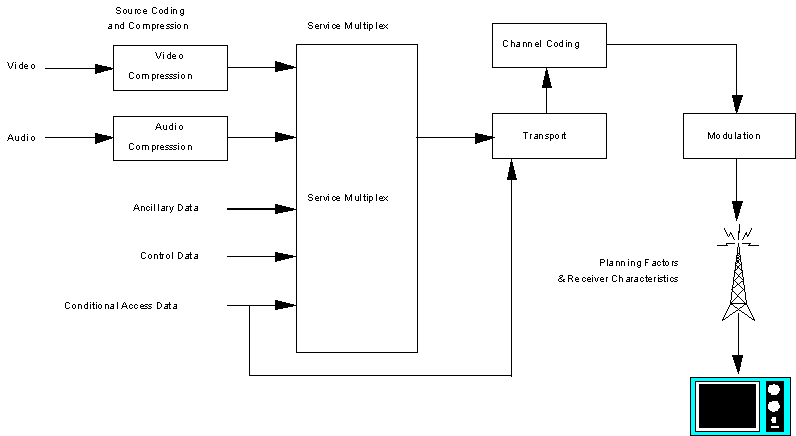2.1 The challenge
The application of digital technology to broadcasting provides three primary advantages:
The application of digital technology to the television sciences encompasses a number of separate technical disciplines and processes:
The process of digitizing conventional 525-line or 625-line television images results in a video data stream on the order of 270 Mbits/s. [1][2][3] The process of digitizing HDTV images results in a video data stream on the order of 1200 Mbits/s. [4] The technology available in 1992 appeared to be able to support the transport of digital data streams in terrestrial television channels or to efficiently utilize the data space on a satellite transponder at the rate of approximately 3.5 to 4.0 bits/Hz of channel bandwidth. A 6,7 or 8 MHz channel could then be expected to support a data stream of approximately 20 Mbits/s. This implied compression of the data representing the original source images at a rate as high as 60:1 to accommodate the need to provide HDTV services. The data stream must also provide for the transport of associated audio and ancillary data services such as captioning, programme identification, etc.
2.2 The ITU DTTB model

Within the International Telecommunications Union, Radiocommunications' sector (ITU/R), Task Group 11/3 was organized and charged in January 1992 with responding to the urgent question concerning digital terrestrial television broadcasting [5]. Task Group 11/3 established a model of a digital television broadcasting system and used the model as the basis of its investigations. The model was divided into four subsystems (reference Figure 1):
"Source coding" refers to bit-rate reduction methods also known as data compression and error protection techniques that are appropriate for application on the video, audio, and ancillary digital data streams, The term "ancillary data" includes control data, including conditional access control, and data associated with the programme audio and video services such as closed captioning. "Ancillary data" can also refer to independent programme and data services.
The "service multiplex and transport" refers to the means of dividing the digital data stream into "packets" of information, the means of uniquely identifying each packet or packet type, and the appropriate means of multiplexing the video data stream packets, the audio data stream packets, and the ancillary data stream packets into a single data stream. Interoperability or harmonization between digital media such as terrestrial broadcasting, cable distribution, satellite distribution, recording media, and computer interfaces must be a prime consideration in developing an appropriate transport mechanism.
The "physical layer" refers to the means of using the digital data stream information to modulate the transmitted signal. The discussion of modulation techniques includes channel coding and error protection techniques using both single carrier and multiple carrier schemes.
"Planning factors and implementation strategies" include discussions of strategies appropriate for the introduction and implementation of digital terrestrial television broadcast service taking into account existing broadcast services. The plans for any such strategies must recognize the interference characteristics of the over-the-air media and the practical limitations imposed at the receiver.
References
Return to DTTB Tutorial Table Of Contents